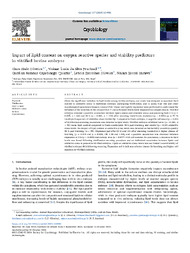Impact of lipid content on oxygen reactive species and viability predictors in vitrified bovine embryos.
Impact of lipid content on oxygen reactive species and viability predictors in vitrified bovine embryos.
Author(s): OLIVEIRA, C. S.; FEUCHARD, V. L. da S.; QUINTAO, C. C. R.; OLIVEIRA, L. Z.; SARAIVA, N. Z.
Summary: Given the significant variation in lipid levels among bovine embryos, our study was designed to associate lipid content to oxidative stress in individual embryos undergoing vitrification, and to assess how this and other morphological parameters impacts cryosurvival. Linear and logistic regression were performed to understand the influence of the variables in the cryosurvival. T-test or Kruskal Wallis were employed to compare means. Vitrified embryos revealed a positive correlation between lipid content and oxidative stress post-warming both 2 h (p = 0.025, n = 64) and 48 h (p < 0.001, n = 122) after warming. Lipid levels explained (p < 0.001) up to 51 % (multiple R-squared) of oxidative stress variability. Compared to fresh embryos, a negative influence (p = 0.01) of vitrification-warming procedures was detected in lipid levels. Vitrified embryos exhibited lower (p < 0.001, n = 90) mean lipid content compared to fresh counterparts 48 h post-warming, and similar (p = 0.24) oxidative stress levels. No impact of lipid content or oxidative stress levels was detected on hatchability or embryo quality 48 h post-warming (n = 99). Expansion just after (0 h) and 2 h after warming resulted in a higher chance of hatching (p = 0.015 and p = 0.008, OR 1.30 and 1.58), and a positive association was observed between expansion at 0 h (p = 0.002) and embryo area (p = 0.047) with cell number. In conclusion, a decrease in lipid levels was found following vitrification-warming procedure and an individual association between lipids and oxidative stress is present in vitrified embryos. Lipids or oxidative stress levels was not linked to survivability of vitrified embryos 48 h following warming. Expansion at 0 h indicates a better chance for hatching and higher cell numbers in vitrified embryos.
Publication year: 2024
Types of publication: Journal article
Unit: Embrapa Dairy Cattle
Observation
Some of Embrapa's publications are published as ePub files. To read them, use or download one of the following free software options to your computer or mobile device. Android: Google Play Books; IOS: iBooks; Windows and Linux: Calibre.
Access other publications
Access the Agricultural Research Database (BDPA) to consult Embrapa's full library collection and records.
Visit Embrapa Bookstore to purchase books and other publications sold by Embrapa.

